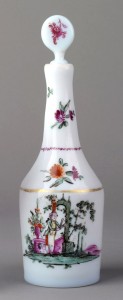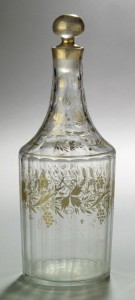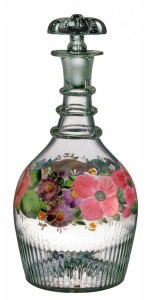The fashionability of different serving vessels changed over time, and wine bottles gradually were replaced by decanters on many elegant dinner tables. Tastes in the beverages served in such vessels also changed. Robert Roberts was a servant of Christopher Gore, a governor and senator from Massachusetts. Roberts’s Guide for Butlers & Other Household Staff, published in Boston in 1827, may be the first commercial publication by an African American author. In the section “Waiting on Dinner,” servants are informed that
sometimes there is champaign, porter or ale handed round, while at cheese; but in other families, while at the second course; and in others when the dessert is put on the table . . . the gentleman of the family most commonly gives directions about his wines, and when they are to be put on the table.
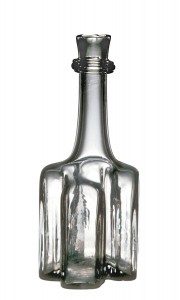 Carafe or decanter
Carafe or decanter
England; 1700–1730
Glass (lead)
Museum purchase 1970.265
Two cruciform (cross-shape) decanters were excavated at the Newmarket archaeological site in the Society Hill section of Philadelphia, formerly the location of a row of town houses. Such vessels were molded to create a greater surface area that may have been advantageous when chilling beverages. Cruciform decanters are virtually unknown with engraved or other ornament and seem not to have included glass stoppers, though the rings at the rim were suitable for securing a cork.
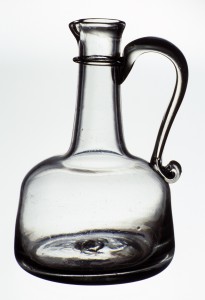 Bottle decanter with handle
Bottle decanter with handle
England; 1720–40
Glass (lead)
Museum purchase with funds provided by the William Penn Foundation in memory of
Mrs. Leola J. Willaman 1978.202
Wine bottle
England; 1720–35
Glass (nonlead)
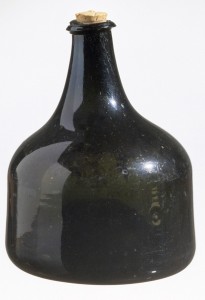 Bequest of Henry Francis du Pont 1959.1729
Bequest of Henry Francis du Pont 1959.1729
The body shapes of decanters made around 1700 echo those of contemporary wine bottles. Decanters with handles are rare, but they are occasionally listed in period documents. Virginia’s Royal Governor Dunmore, for example, ordered “six dozen quart bottle decanters, with handles” in 1773.
Decanter with classical ruins (left)
Probably Graf Harrach factory
Neuwelt, Bohemia (Czech Republic); 1770–1800
Glass (nonlead)
Bequest of Henry Francis du Pont 1969.1430a,b
Decanter (one of pair) with grapevine (center)
Bohemia (Czech Republic); 1800–1820
Glass (nonlead)
Bequest of Henry Francis du Pont 1965.2849a,b
Decanter with floral wreath (right)
Europe, possibly Germany(body), England or United States(stopper); 1800–1850
Glass (nonlead, body), glass (lead, stopper)
Bequest of Henry Francis du Pont 1964.2067a,b
Decanters from northern Europe were quite popular and available in a broad price and fashion range in early America. The white decanter with enameled classical ruins and the more-costly gilt and hand-cut grapevine-pattern example are both in the popular neoclassical taste. The molded ribs on the colorful wreathed decanter imitate expensive cut fluting found on some English and American glass; the cheerful flowers would have appealed to a middling-income market.
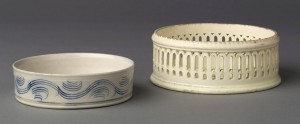 Coasters, slides, or stands
Coasters, slides, or stands
Probably Staffordshire, England
Salt-glazed stoneware; 1755–75 (blue and white)
Earthenware (creamware); 1780–1800 (cream color)
Bequest of Henry Francis du Pont 1958.933; Museum purchase 1980.121
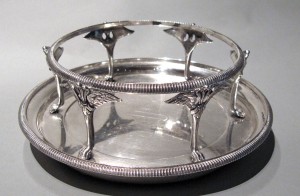 Coaster, slide, or stand with Bonaparte family arms
Coaster, slide, or stand with Bonaparte family arms
Samuel Kirk & Son
Baltimore, Maryland; 1846–61
Silver, wood, cloth
Gift of Dr. Richard C. Weiss and Dr. Sandra R. Harmon-Weiss 1997.33
Coasters, slides, or stands helped protect tables and tablecloths from drips. They were available from the mid-1700s onward in a range of prices and materials. Records from Josiah Wedgwood’s factory indicate some coasters were available in graduated sets. The rare American silver coaster shown here bears the Bonaparte family coat of arms for descendants of Jerome Bonaparte, the youngest brother of Napoleon.
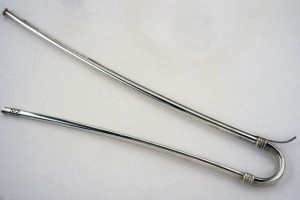 Wine siphon
Wine siphon
England or United States; 1750–1820
Silver
Gift of Marshall P. Blankarn 1977.82
Wine siphon with pump
Frederick Marquand
New York, New York; about 1830
Silver, ivory
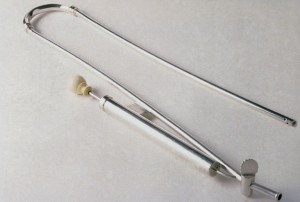 Gift of Henry Francis du Pont 1961.651
Gift of Henry Francis du Pont 1961.651
Wine siphons were used to transfer liquid from bottles to decanters without disturbing and moving the dregs. Most included a small tube on the side that could be sucked to prime the siphon. Rarer examples have attached pumps or taps to stop or start the flow of the wine. Marquand, the maker of the siphon with the ivory mounts, was a second-generation silversmith in a firm that was active in New York and Georgia. He is listed in New York City directories as a manufacturer of jewelry, silver plate, and spoons. Quite successful, he donated the funds to build Marquand Chapel at Yale University.
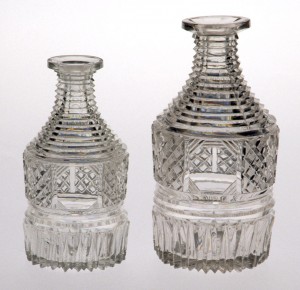 Decanters
Decanters
Bakewell, Page & Bakewell factory
Pittsburgh, Pennsylvania; 1823
Glass (lead)
Gift of Mr. and Mrs. Evelyn du Pont Irving 1953.1.1, .2
These fashionable pint- and quart-size decanters are from a set of four ordered by Wilmington, Delaware, black-powder manufacturer Eleuthère Irénée du Pont, the great-grandfather of Winterthur founder Henry Francis du Pont. Early documents indicate that the Bakewell factory did not receive instructions from du Pont regarding engraving for the octagonal empty spaces on the decanters, so they were left plain.
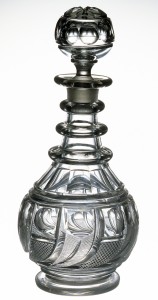 Decanter
Decanter
United States; 1825–40
Glass (lead)
Gift of William A. Henry in memory of Bessie Maynard Henry 1984.96.1a,b
This globe, or pear-shape, cut-glass decanter is in a popular style, and the swirling “peacock eye” or “comet” design was produced at several factories, including Bakewell in Pittsburgh. It was also made in less-costly molded glass. Although this pattern has sometimes been thought to commemorate the passing of Halley’s Comet in 1835, the comet design actually appears in American documents as early as the 1820s.
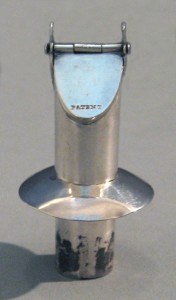 Decanter (or bottle?) stopper
Decanter (or bottle?) stopper
Probably United States; 1850–70
Silver
Bequest of Henry Francis du Pont 1963.682
Both domestic and imported decanter or bottle stoppers were available to Americans during the 1700s and 1800s. In 1771 Philadelphia goldsmith and jeweler John Carnan advertised “silver mounted decanter corks.” In a 1772 Virginia Gazette, milliner Catharine Rathell offered plain and “labelled Silver topped Decanter Corks” at her Williamsburg shop. Some labeled examples bore the names of specific types of wines.
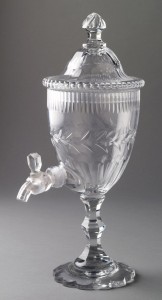
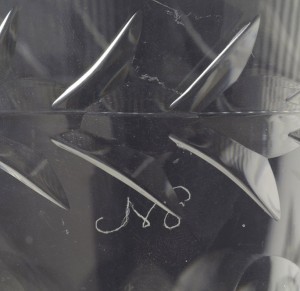 Wine fountain
Wine fountain
Ireland or England; 1790–1810
Glass (lead)
Incised “N 8” and “6” (twice)
Museum purchase with funds provided by Special Funds for Collection Objects 1975.17a,b
This rare and elegant vessel takes its shape from metalwork versions and, like high-end decanters, was used in wealthy households to serve wine, other alcoholic beverages, or water. The classical profile and style of the cut decoration help date it to around 1800. The incised “N 8” above the spigot may indicate this is one of a set; the apparently mismatched spigot is twice-numbered “6.”
Related Themes:

